Following their Continental Cup final defeat to Arsenal Women and their departure at the hands of Manchester United Women in the Women’s FA Cup semi-finals, Chelsea Women’s hopes of ending Emma Hayes’ final season in charge with a cup competition triumph have rapidly deteriorated, with only the Champions League left available to them (alongside another potential WSL title).
What has made the European trophy even more desirable than normal this season is that it is the only one that Hayes has yet to get her hands on, with Chelsea reaching the final back in 2021 but having yet to get over the final hurdle. As a result, it is the one that the team are intent on winning, with the knowledge that doing so in Bilbao in May will complete their departing manager’s personal honours list.
To reach the final, though, they will have to navigate their way through a two-legged semi-final tie against the immoveable object that is Barcelona Femení, with the defending champions managing to see off every threat to their throne so far and intent on winning a third title in four years. The first leg took place at the weekend, and, to the surprise of many, it was Chelsea who won the game, ending Barcelona’s five-year winning run on home soil and ensuring that they will have an advantage in the second leg, which takes place at the weekend at Stamford Bridge.
It was widely anticipated to be an intense and highly engrossing affair between two of the continent’s strongest sides. It proved to be just that, with both Hayes and opposite number Jonatan Giráldez looking to outmanoeuvre each other during the 90 minutes. This tactical analysis will break down why it was Chelsea who took the win and why, despite showing some strong tactical adaptations, Barcelona will arrive in London with it all to do.
Lineups

Despite Barcelona Femení having had a whole week to prepare for this game, with their previous outing being the home Liga F victory against Villarreal Femenino, Giráldez had decided not to take any chances and had heavily rotated his squad in order to keep the majority of his first-choice names as fresh as possible. As a result, goalkeeper Cata Coll, defenders Ona Batlle, Irene Paredes and Fridolina Rolfö, midfielders Ingrid Engen and Keira Walsh and forwards Caroline Graham Hansen and Mariona Caldentey all came back into the fold, with Engen starting in defence due to the continued injury absence of star centre-back Mapi León.
Chelsea Women, on the contrary, had had to get a midweek WSL fixture at home to Aston Villa Women out of the way before they could fully focus on the trip to the Estadi Olímpic Lluís Companys (Barcelona’s main stadium whilst Camp Nou is being renovated). However, Hayes had opted not to rest key names in that match, with the only new names in her starting lineup in Spain ones being winger Johanna Rytting Kaneryd, midfielders Melanie Leupolz and Erin Cuthbert and forwards Lauren James and Mayra Ramírez.
Chelsea Women’s game plan
Whilst she had opted for minimal changes to Chelsea Women’s starting XI from the win against Aston Villa, one big alteration that Hayes did make was to the starting formation, with her side setting up in a 3-5-2 shape for this match. It was a move that did raise a few eyebrows at first, due to it not being a system that Hayes has relied on before, but it soon became clear why she had turned to it and the benefits it would bring to their performance.
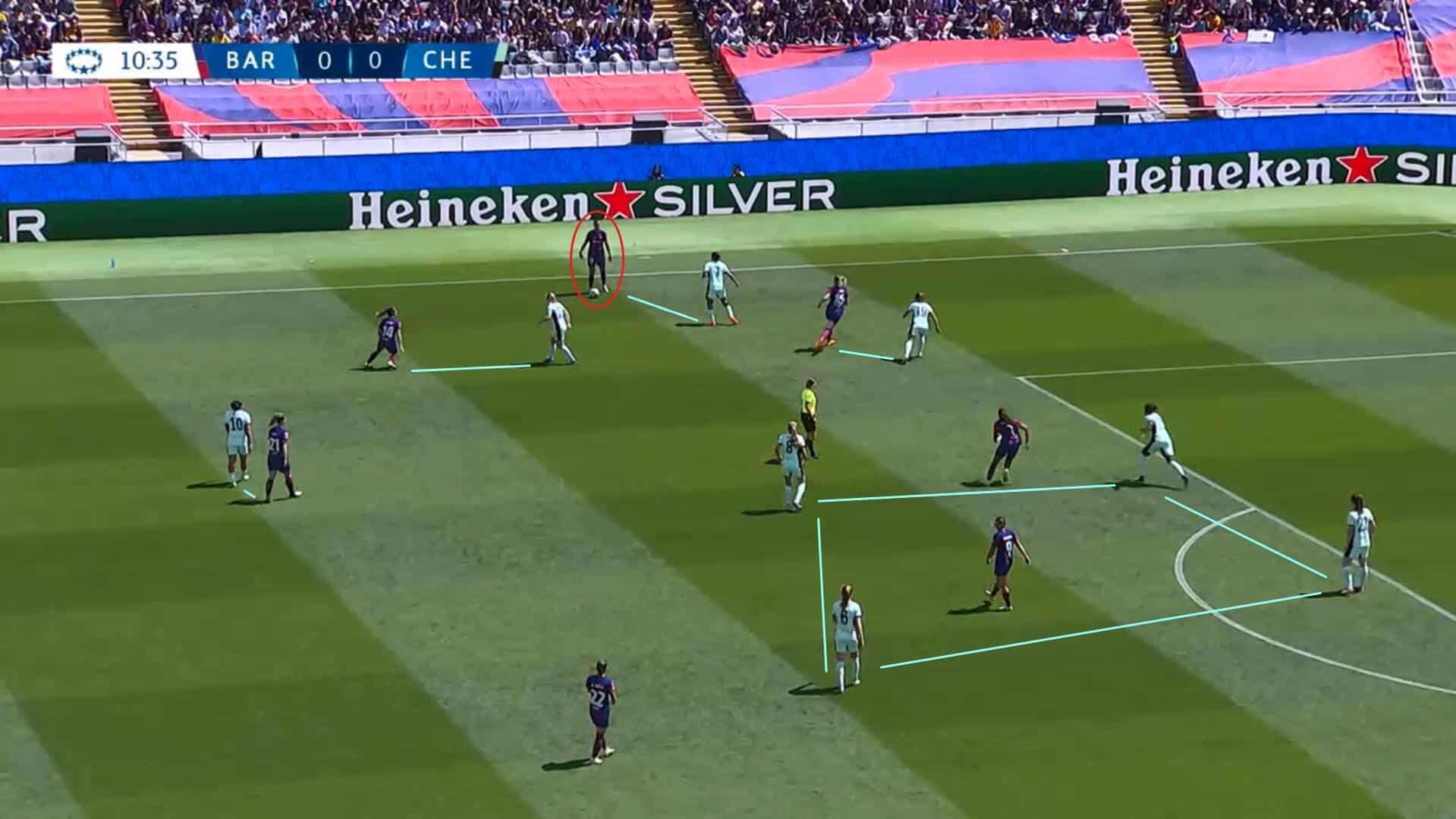
For starters, it allowed them to implement a clever player-to-player marking system that Hayes had designed to ensure that Barcelona Femení would have as little chance as possible to exert their usual attacking threat, with it clear as the first half went on that their game plan revolved around spending extended periods of time without the ball and on not making it possible for their hosts to play through them with their usual speed and precision.
However, it was not simply a case of setting up in a low block because there was a clear organisation to the way that Chelsea looked to ensure that they left no options open for Barcelona to exploit. That started with the back three, who were tasked with each picking up one of Barcelona’s front three and ensuring that they never had a chance to shoot at goal, and that is shown here through both Salma Paralluelo and the aforementioned Caldentey being closely monitored by Kadeisha Buchanan and Niamh Charles, with support from the midfield duo of Sjoeke Nüsken and Leupolz.
Once that part of the team was set up, it then became about closing down every other Barcelona player in the vicinity, and what aided Chelsea with that was that they had kept their third centre-back free to operate wherever needed. In this case, Jess Carter has pushed out to the wing to mark Patri Guijarro, which has, in turn, freed Cuthbert up to focus her attention on Aitana Bonmatí, who had crept up to offer a secondary passing option behind her. At the same time, Walsh had been marked by James behind them, whilst Rytting Kaneryd had stayed tight to her Sweden teammate Rolfö as she, too, moved up the pitch to support the attack.
With all of this in place, Guijarro now has the ball at her feet on the far side of the pitch, but with no teammates available for her to pass to, and the fact that Carter was moving to close her down meant that she couldn’t just hold her position and wait for one to become free either. As a result, she was forced to pass backwards here, and Barcelona needed to build again and the fact that this happened several times in the first half means that it played a major role in Chelsea preventing their opponents from getting into their usual flow.
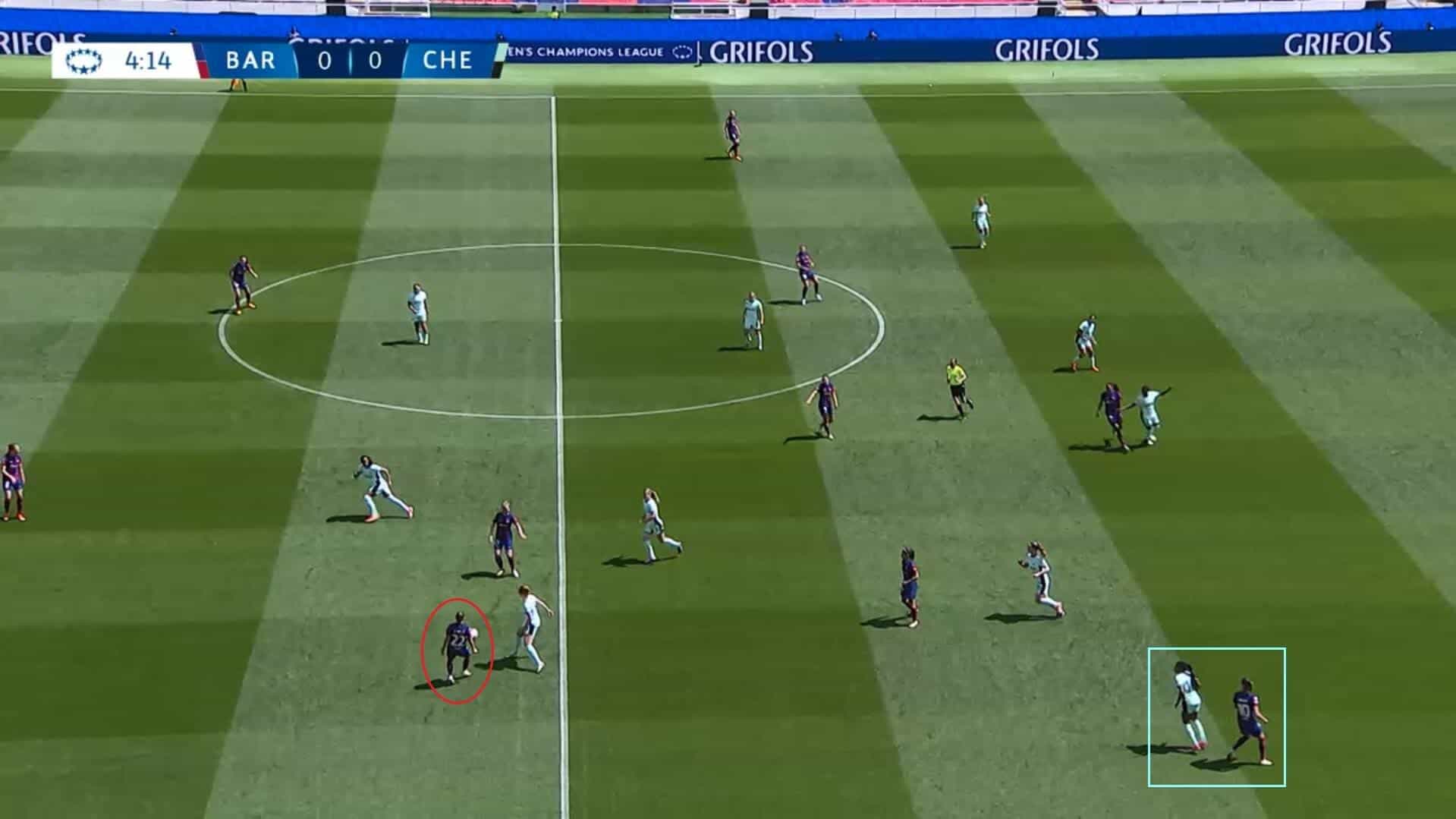
The other thing that Hayes put a strong emphasis on was to remove Graham Hansen from the equation, with the Norway international undeniably the home side’s biggest weapon whenever they have had the ball this season. With her capable of creating chances with deliveries from wide areas and when cutting inside of scoring as well as setting up goals, there is every reason to want to stop balls reaching her. Hayes looked to do that by shifting Charles inside to function as a centre-back and by starting former PSG Féminine full-back Ashley Lawrence in the left wing-back position, with the Canada international having the pace and sharp changes of direction needed to stay tight to Graham Hansen for the entirety of the match.
In many ways, Chelsea were able to take note of the way that Brann Kvinner looked to mark her tightly, with their game plan also reverted around limiting her threat when facing the defending champions in the quarter-final stage. Whilst they did end up losing 5-2 on aggregate, the first leg ended in a narrow home defeat for the Bergen club, with Graham Hansen having a slightly frustrating night in her home country.
Therefore, what Chelsea needed was to find a player in their squad with the endurance to compete in what would be a really tough 1-v-1 duel, and Lawrence has shown throughout her career that she has that ability. Her presence certainly made Barcelona think twice when looking to move up the field, with Batlle initially seeing if Graham Hansen was available here before opting to pass horizontally instead.

It was only out of possession that the visitors demonstrated strong tactical nous though, and the fact that they started to see more of the ball as the first half went on meant that they were able to demonstrate another aspect of their game plan, namely their desire to be direct whenever they did have a chance to construct an attacking opportunity.
This was largely facilitated by Chelsea starting Ramírez at the top of the field, with the Colombia striker having the type of profile that unsettles opposing defensive lines, and her presence and ability to both hold the ball up and to run in behind gave the Barcelona back line a torrid time. Her tendency to play on the shoulder meant that they were forced to split from the midfield whenever they didn’t have the ball, with that fissure then being exploited by the midfielders.
They had to make some alterations in the second half to ensure that this tactic retained its effectiveness. Ramírez came under increasing pressure from the Barcelona defenders, and Catarina Macario was introduced to relieve that by providing a second outlet. However, the fact that the only goal of the game came in the first half when Nüsken set up Cuthbert in the void that those forward runs had created means that, again, Chelsea’s success was down to their coherent game plan and the fact that everyone was tactically united on the day.
Barcelona Femení’s first-half issues
Given all of that, it becomes immediately apparent as to why Barcelona Femení struggled to get into the game in the first half, with it mentioned earlier in the analysis that they saw plenty of the ball but that they were rarely able to do anything with it.
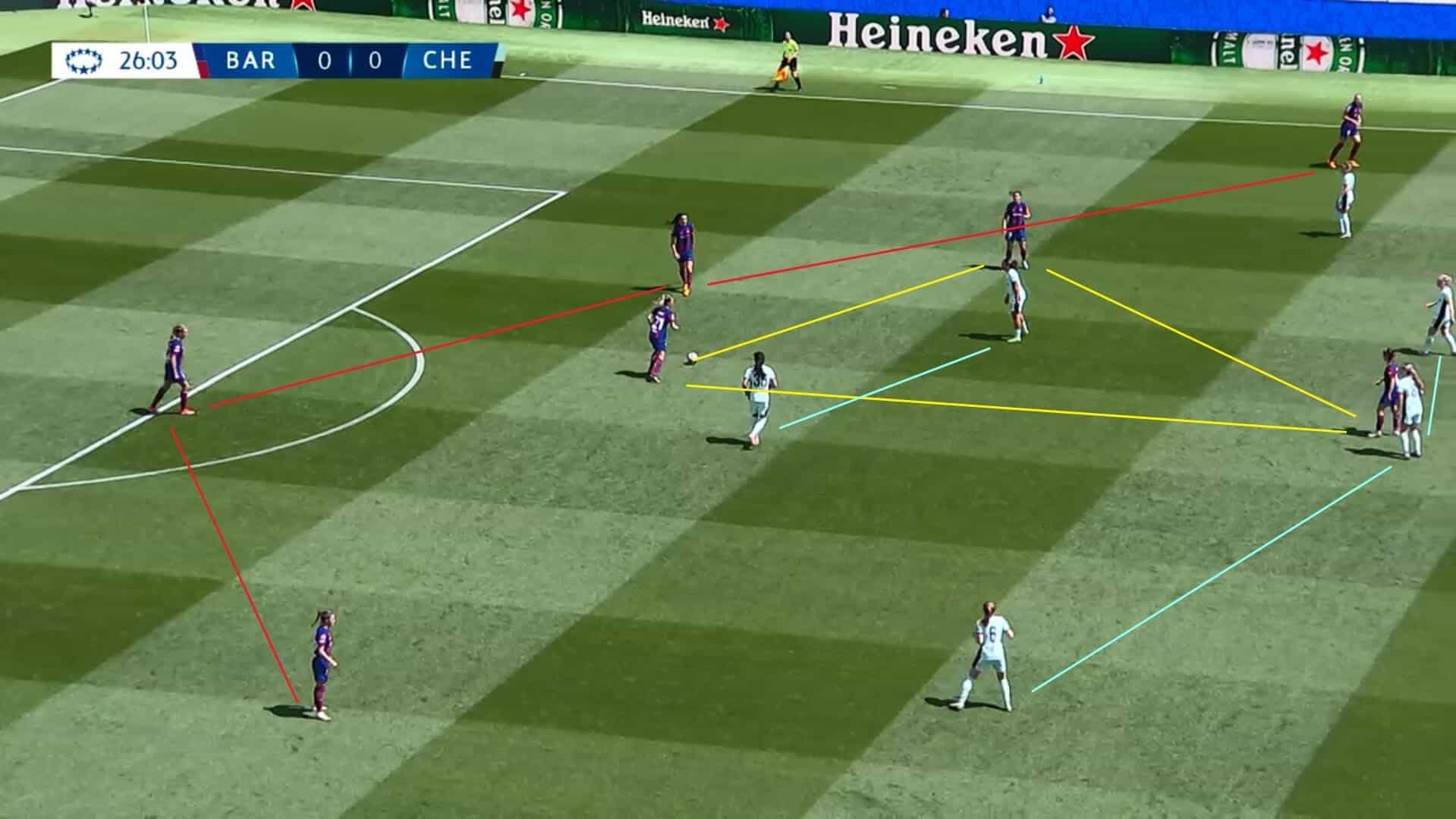
However, it was not only Chelsea Women’s clever play that was the reason for that, with another being that they lacked the same tendency to spread around the pitch before the break, with it instead being the case that the midfielders would drop back to play in very close proximity to the back four, meaning that they ended up making several short passing sequences but without gaining any territory.
This has been shown here by Walsh and Guijarro dropping back to offer themselves as passing options, and what is clear to see is that Chelsea are not pressing forward and are instead sitting off those six players. This is because Barcelona’s tendency to get into tight spaces like this inside their own third played directly into their hands, with the front two of James and Ramírez now able to monitor where the ball is whilst the only midfielder not involved here, Bonmatí, is higher up the pitch and is being marked by the trio of Nüsken, Leupolz and Cuthbert.
Again, this highlights Chelsea’s organisation around the field, but it also shows how Barcelona were, at times, their own worst enemies. They were too negative before the break, making it far too easy for them to be contained.
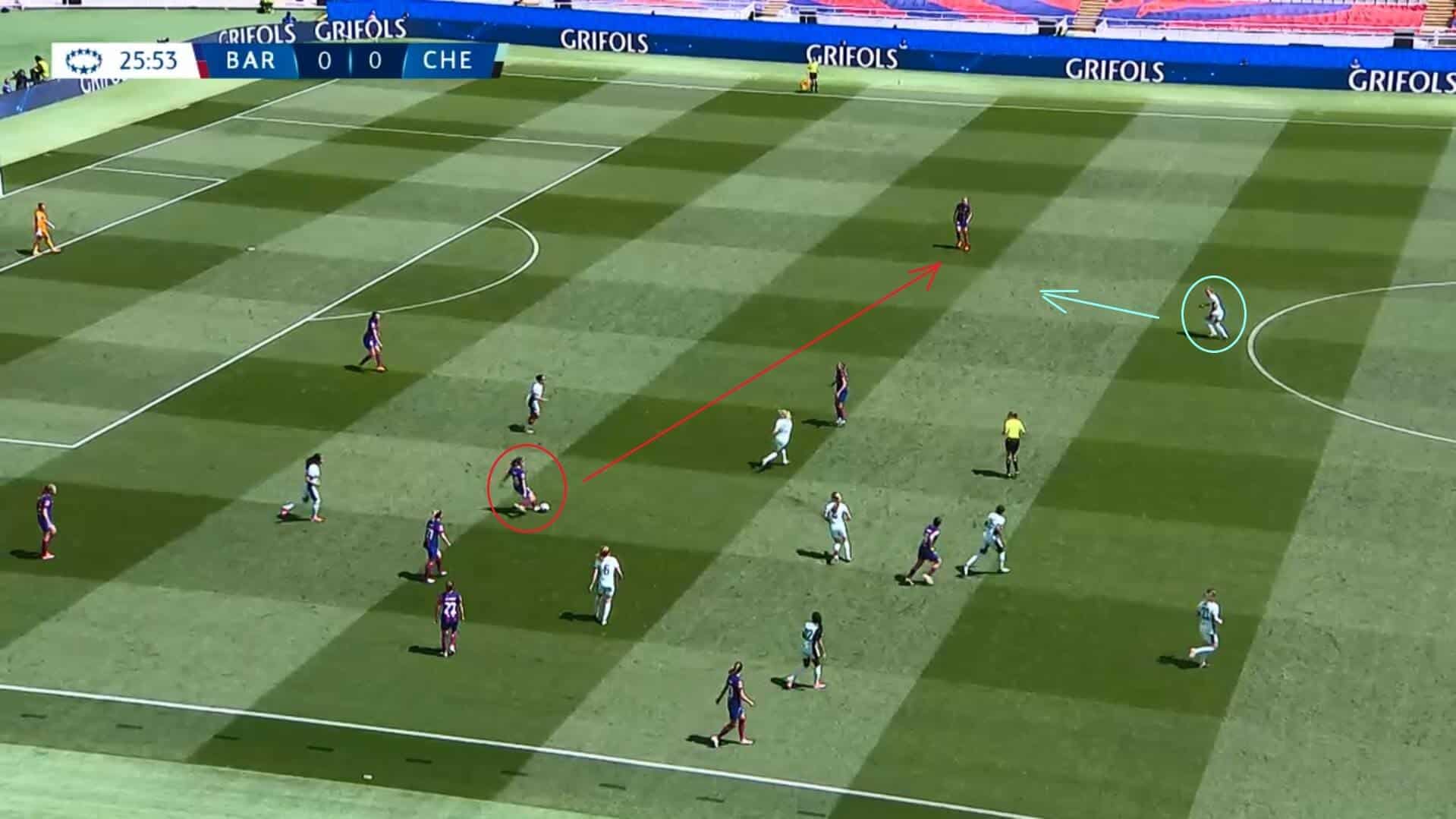
This is not to say that they never had space to work with, with there being some instances when gaps did open up, and they could make longer passes around the pitch.
However, as with their tendency to crowd the ball, there was a definite feeling of nervousness in their play, and it lacked the same crispness, with passes being marginally under-hit or not travelling in the correct direction. Their recipients often had to correct their runs to control the ball, which also prohibited their ability to build any momentum. In this case, it is Bonmatí who has got on the ball and who has looked to send the ball towards Rolfö, with the Sweden international in acres of territory, and she was one of Barcelona’s key threats in the first half due to Rytting Kaneryd tending to drift infield at times.
However, on this occasion, the Chelsea player recovered and got forward to press Rolfö, continuing their individual battle on the far side of the pitch and forcing her to pass the ball back towards her own goal area. At that point, Walsh dropped back, and the same pattern emerged, with more short passes that once again didn’t lead to anything. It was clear that this was one big reason for Barcelona rarely troubling their opponents in the first half.

When the Spanish side are in situations like this and are struggling to find a way up the field, Bonmatí is generally the player that they turn to and who can always be relied upon to provide a spark and to be the catalyst for a series of quick transitions.
However, she struggled individually to really exert her influence on proceedings, with her pass map for the game indicating that she had plenty of touches of the ball and in all of the usual areas but that the vast majority of her passes were either sideways or backwards, just like this one. Therefore, with her not managing to make the same contributions, coupled with the way that Graham Hansen was largely marked out of the game, it is abundantly clear why Barcelona dominated possession in the first half but lacked an ability to turn it into anything significant.
Barcelona Femení’s second-half adaptations
It was apparent that something had to change if Barcelona Femení were to get back into the game, and that was something that Giráldez clearly also felt, with him demonstrating as the second half went on why he is regarded by many as one of the brightest minds in the women’s game.
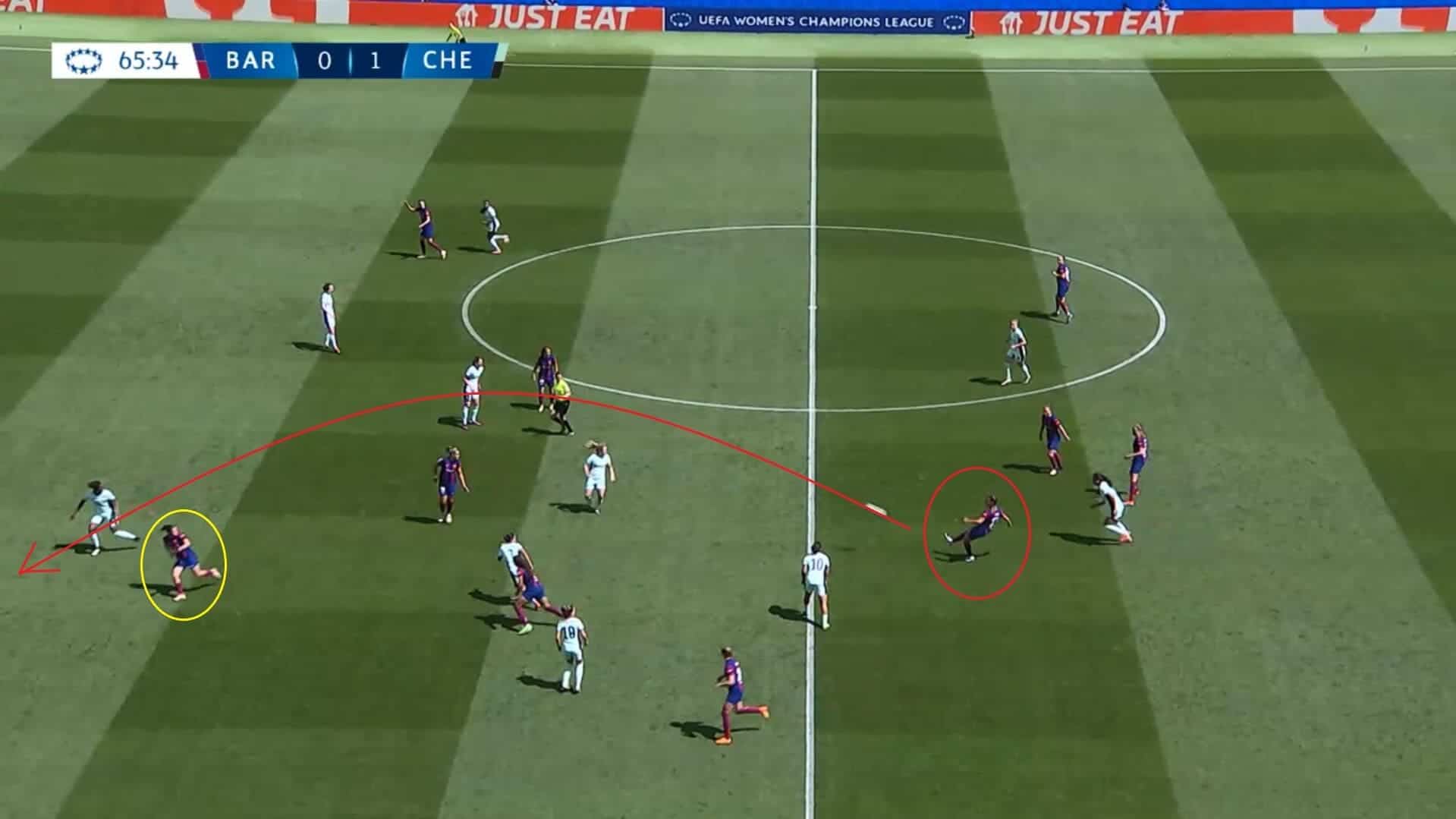
The first alteration that Giráldez made was to his team’s style of play, with him introducing Alexia Putellas for Engen partway through the second half and dropping Guijarro back into central defence.
There were several reasons for this, one of which was that the defending champions could implement more direct tactics. Guijarro was capable of making the aerial passes that Giráldez felt would bypass the Chelsea Women midfield threat. This did lead to more chances being created, as the likes of Caldentey and Paralluelo were found more often.
Another was that Guijarro gave Barcelona a stronger ability to limit Ramírez’s ability to breach their back line in the same manner as she had been in the first half, and it has already been mentioned that Chelsea had to make changes in attack due to Barcelona increasing the pressure on the striker. That came as a result of Guijarro making life a lot less comfortable for her and the two engaging in what ended up being a highly physical 1-v-1 battle that spanned the majority of the second period, leading to several fouls and a yellow card for the Barcelona player as she worked hard to limit the former Levante Femenino attacker’s ability to get behind her in the same way.
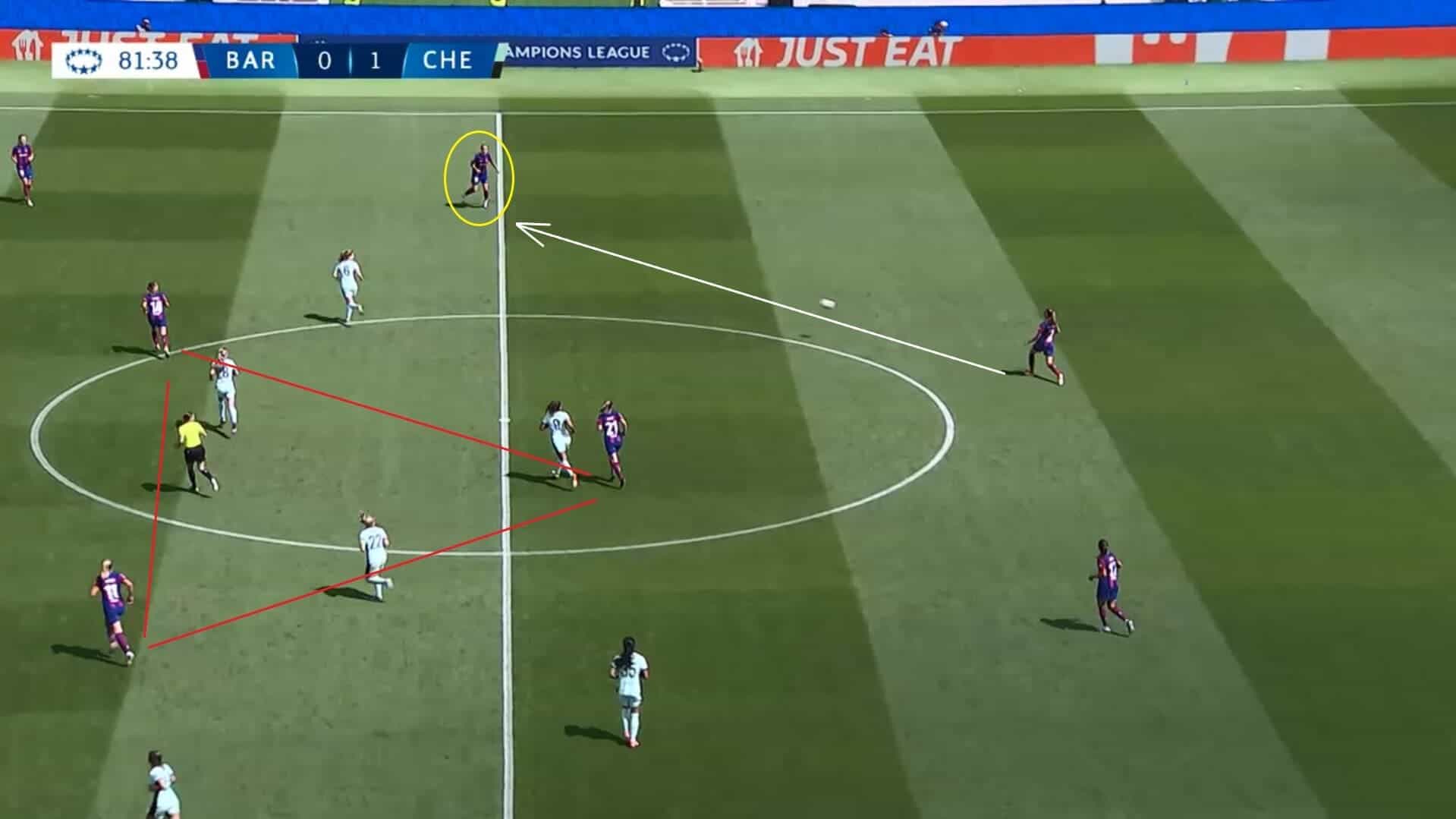
The decision to bring on Putellas for Engen was also a carefully planned move, giving Barcelona another attacking midfield presence and allowing them to bias their midfield towards the top of the pitch. Her presence gave Chelsea a different presence to deal with in the central third and made it a lot harder for them to contain the space in the same way, with Putellas instigating the passing triangles that form such a prominent part of Barcelona’s tiki-taka brand and that they had struggled to create before the break.
The decision to bring on Lucy Bronze for Batlle at right-back also helped, with the England international more known for her attacking threat and so pushing up the field much more. As a result, Chelsea were forced to commit more numbers to the wide areas and, therefore, leave more spaces open for the likes of Putellas to use to her advantage, whilst it also allowed Graham Hansen to position herself further inside the pitch and to, therefore, play a larger role in the game than she had been allowed to whilst staying further out.
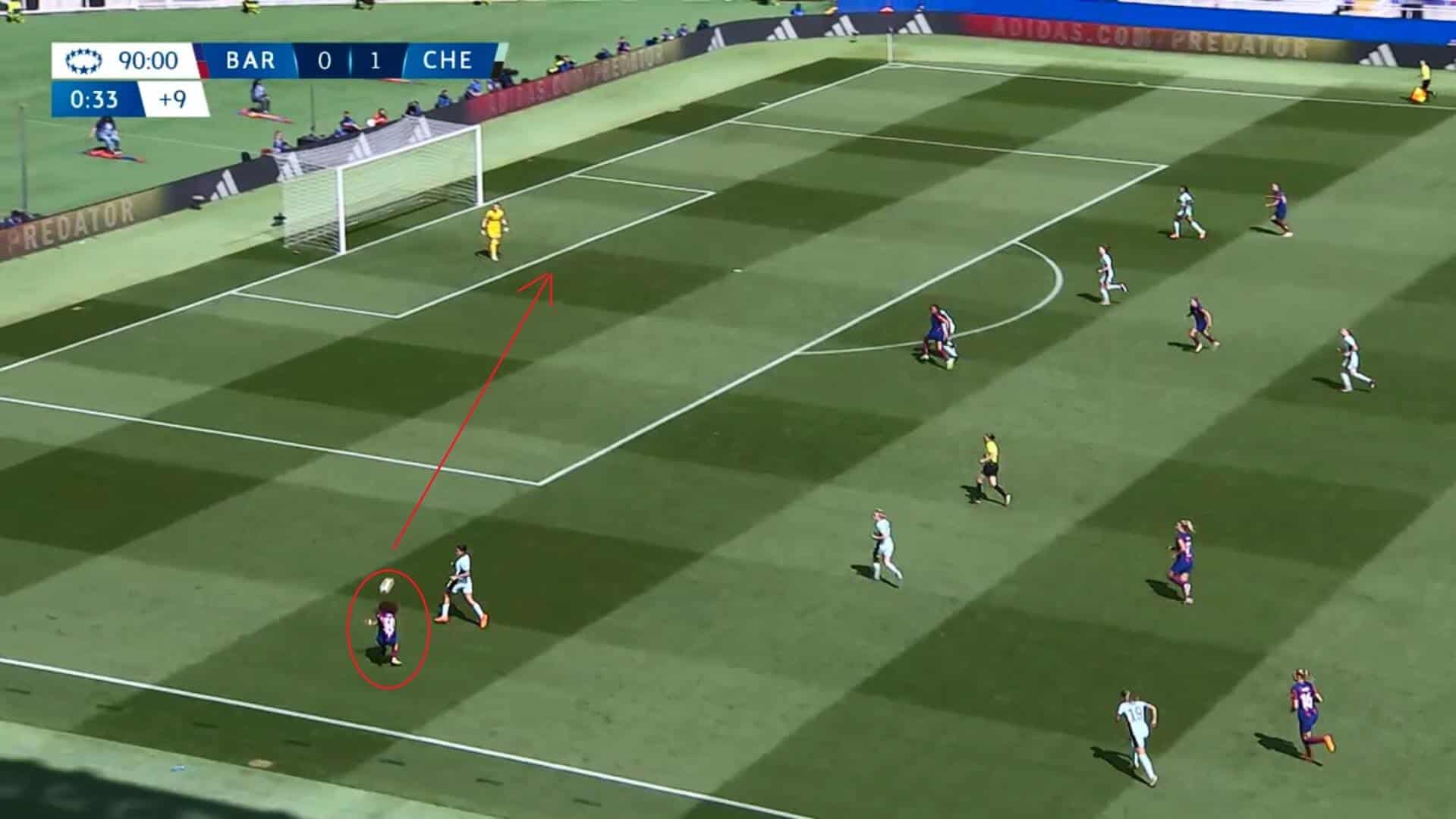
Whilst all of these substitutions worked in their own way and allowed Barcelona to start to put Chelsea under more pressure, the fact remains that they failed to score and that they will go into this weekend’s second leg behind the London side.
When breaking down the game, it is clear that this was not due to a lack of chances, with them enjoying more freedom inside the final third. What really let them down was their poor quality when making final passes, crosses, and shots. In this case, substitute Vicky López received the ball after a one-two pass with Rolfö and now got herself into an area where she had time and space to pick out a teammate in the middle.
However, the delivery ended up travelling on too straight a trajectory. It was easy for Chelsea goalkeeper Hannah Hampton to come out and gather it in the air, with Barcelona wasting a promising opportunity to test their opponents’ defensive resolve. This happened time and time again in the second half, with Paralluelo firing wide after Graham Hansen had found her and Putellas missing the target from inside the goal area with virtually the last kick of the match. It is hard not to feel that the home side had enough chances to win this match and that their lack of productivity could cost them in the wider context of the tie.
Conclusion
In conclusion, this tactical analysis has looked in detail at the first leg of the Champions League semi-final match between Barcelona Femení and Chelsea Women, highlighting the reasons for Chelsea taking an unexpected but deserved lead into the second leg and the reasons that Barcelona fell short on home soil.
As the analysis has made clear, Hayes’ side deserve a lot of credit for the way that they approached this encounter and for their overall setup, with it clear that they had worked on a formula that would deliver what they needed from this tie and that every player was on board with it.
Barcelona will be frustrated after this match, but it is only halfway through, and there is still a chance for them to reach another final and defend their title. It will be tight, with them likely to face a hostile atmosphere at Stamford Bridge and travelling to Levante Las Planas in a midweek Liga F match before making the trip, but they have proven on numerous occasions that they have what it takes to get results in tough places and to do what is required. Chelsea will, therefore, need to be on their guard if they are to finish the job on Saturday evening.





Comments